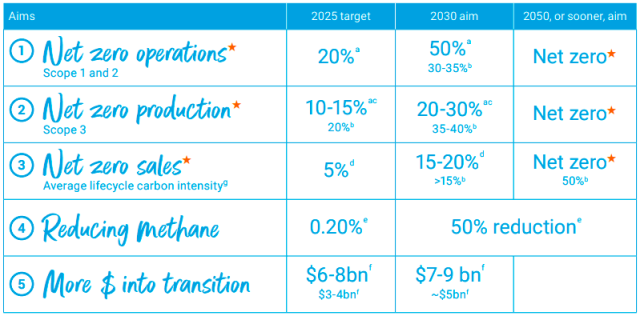Energy major BP, which is aiming to become net zero across operations, production and sales, by 2050 or sooner, has released its sustainability report 2022.
BP CEO Bernard Looney has set up five targets to achieve in order to become net zero across operations, production and sales, by 2050 or sooner.
BP aims to increase the proportion of investment we make into non-oil and gas businesses. Over time, its investment will go up in low and zero carbon and will go down in oil and gas.
In 2022, BP’s transition growth investment was $4.9 billion compared to $2.4 billion in 2021 – this was around 30 percent of total capital expenditure for the year, up from around 3 percent in 2019.
BP said its annual transition growth investment will be reaching $6-8 billion in 2025 and $7-9 billion in 2030.
BP, as announced in February 2023, is targeting to increase the proportion of annual capital expenditure invested in transition growth engines to more than 40 percent of total spend by 2025 and to around 50 percent by 2030.
BP aims to install methane measurement at all its existing major oil and gas processing sites by 2023, publish the data, and then drive a 50 percent reduction in methane intensity of operations. BP will work to influence joint ventures to set their own methane intensity targets of 0.2 percent.
BP said it progressed the deployment of methane measurement approach across all existing major oil and gas processing sites in 2022, with the introduction of enhanced metering, software for flare efficiency and predictive emissions monitoring on gas turbines.
BP said it remains on course to deliver methane measurement aim by the end of 2023. BP’s methane intensity in 2022 was 0.05 percent – an improvement from 0.07 percent in 2021. Methane emissions from upstream operations, used to calculate our intensity, continued on the declining trend they have followed since 2016 (when we reported 111kt), decreasing by 35 percent to around 28kt, from 43kt in 2021. Variations in production and divestments accounted for approximately 85 percent of the absolute reductions reported for 2022, and methane reductions from SERs accounted for 14 percent.
BP aims to reduce to net zero the carbon intensity of the energy products it sells by 2050 or sooner.
This aim applies to the average carbon intensity of the energy products we sell. It is estimated on a lifecycle (full value chain) basis from the use, production, and distribution of sold energy products per unit of energy (MJ) delivered.
In February 2022, BP expanded the scope of its aim 3 to include physically traded energy products as well as marketed sales. In future, it may also cover certain other products, for example, those associated with land carbon projects. Progress on aim 3 is directly linked to its strategy to grow low carbon presence and provide products that have lower lifecycle emissions.
In 2022 the average carbon intensity of sold energy products was 77gCO2e/MJ. This represents a 2 percent decrease from 2019 baseline, primarily driven by a reduction in the lifecycle emissions associated with the sold energy products.
BP aims to be net zero on an absolute basis across the carbon in our upstream oil and gas production by 2050 or sooner.
This is based on BP’s net share of production (around 361MtCO2 in 2019). It is associated with the CO2 emissions from the combustion of upstream production of crude oil, natural gas and natural gas liquids (NGLs). BP is targeting a 10-15 percent reduction by 2025 and will aim for 20-30 percent by 2030 against our 2019 baseline.
Since 2019, estimated Scope 3 emissions have reduced by 15 percent, which is at the upper end of its revised 2025 target of a 10-15 percent reduction against our 2019 baseline.
BP aims to be net zero across entire operations on an absolute basis by 2050 or sooner. This aim relates to Scope 1 (from running the assets within our operational control boundary) and Scope 2 (associated with producing the electricity, heating and cooling that is bought in to run those operations) GHG emissions.
These emissions were around 54.4MtCO2e in 2019. BP is targeting a 20 percent reduction in its aim 1 operational emissions by 2025 and will aim for a 50 percent reduction by 2030 against 2019 baseline.
BP made further progress against operational emissions reduction targets. BP’s combined Scope 1 and 2 emissions, covered by aim 1 were 31.9MtCO2e – a decrease of 41 percent from 2019 baseline of 54.4MtCO2e. The decrease of almost 22.5MtCO2e includes 16.0MtCO2e attributable to divestments and 4.1MtCO2e in sustainable emission reductions (SERs).
Compared with 2021 (35.6MtCO2e), Scope 1 and 2 emissions decreased by 10 percent. BP has already exceeded 2025 target of 20 percent emission reductions against 2019 baseline. However, BP plans to bring new projects online and continue investment to meet its 2030 aim.

